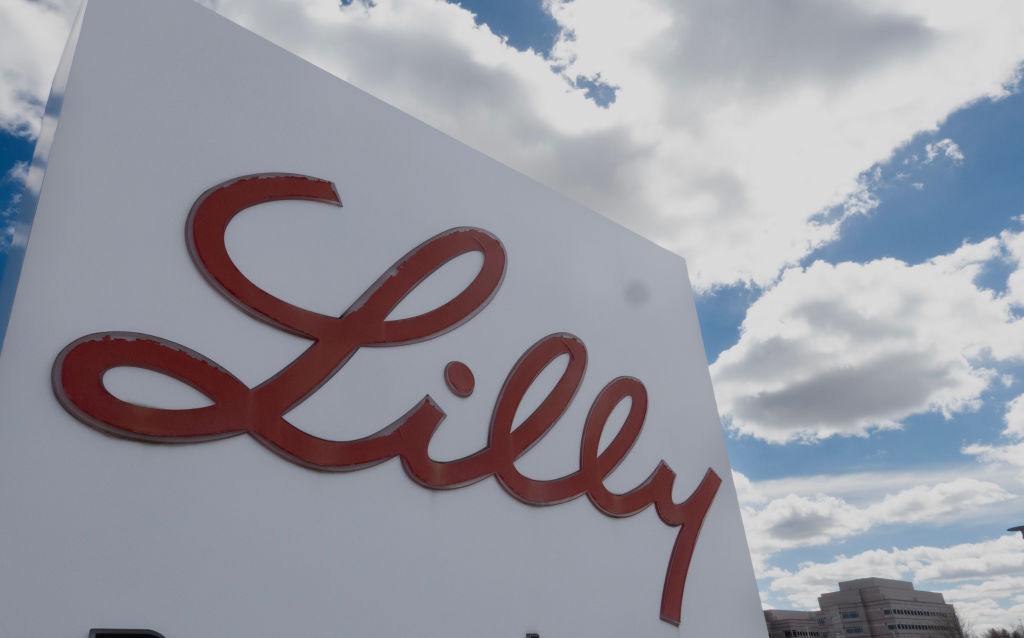Eli Lilly Stock Rises After Profit, Outlook Top Expectations
Eli Lilly stock is higher Thursday after the pharma giant beat fourth-quarter profit expectations and issued strong 2025 guidance. Here's what you need to know.


Eli Lilly (LLY) stock is higher Thursday after the pharmaceutical company beat profit expectations and matched revenue forecasts for its fourth quarter and issued a better-than-expected outlook for 2025.
In the three months ending December 31, Eli Lilly's revenue increased 44.7% year over year to $13.5 billion, driven by demand for its weight-loss drugs, Mounjaro and Zepbound. Earnings per share (EPS) rose 113.7% from the year-ago period to $5.32.
"2024 was a highly successful year for Lilly," said Eli Lilly CEO David Ricks in a statement. In addition to success with its weight-loss drugs, Ricks cited "major data readouts for tirzepatide in treating chronic disease associated with obesity."
From just $107.88 $24.99 for Kiplinger Personal Finance
Become a smarter, better informed investor. Subscribe from just $107.88 $24.99, plus get up to 4 Special Issues

Sign up for Kiplinger’s Free Newsletters
Profit and prosper with the best of expert advice on investing, taxes, retirement, personal finance and more - straight to your e-mail.
Profit and prosper with the best of expert advice - straight to your e-mail.
Eli Lilly also "invested billions more" in its manufacturing capacity and launched Kisunla and Ebglyss. The latter will be "important drivers of our long-term balanced growth outlook," Ricks said. Kisunla is designed to treat early stage Alzheimer's disease, while Ebglyss is for eczema.
The results were mixed compared with analysts' expectations. Wall Street was anticipating revenue of $13.5 billion and earnings of $5.01 per share, according to MarketWatch.
For 2025, Eli Lilly expects to achieve revenue in the range of $58 billion to $61 billion and earnings of $22.50 to $24 per share. The midpoints of these ranges, revenue of $59.5 billion and earnings of $23.25 per share, came in ahead of analysts' expectations of revenue of $58.8 billion and earnings of $22.76 per share.
"We enter 2025 with tremendous momentum and look forward to strong financial performance and several important Phase 3 readouts which, if positive, will further accelerate our long-term growth," Ricks said.
That should support the drug maker's quarterly payout to shareholders as well. Eli Lilly's long track record makes it one of Wall Street's best dividend stock.
Competition in the weight-loss drug category with Novo Nordisk (NVO) and its Ozempic continues to define Eli Lilly's results. A recent Food and Drug Administration clarification of the tirzepatide shortage should help both LLY and NVO.
Is Eli Lilly stock a buy, sell or hold?
LLY tumbled 6.6% on January 14 after management pre-announced fourth-quarter results. Sales for Mounjaro and Zepbound met expectations set in mid-January, and Wall Street sees further upside for the healthcare stock.
According to S&P Global Market Intelligence, the consensus analyst target price for LLY stock is $975.09, representing implied upside of about 14% to current levels. And the consensus recommendation is Buy.
Financial services firm Jefferies has a Buy rating on the large-cap stock with a $994 price target.
"We're bullish on LLY for several reasons," Jefferies analyst Akash Tewari said in a December 19 note, citing Eli Lilly's attractive growth profile in a recessionary environment and the potential for GLP-1s to be among the biggest drug classes of all time.
The analyst also sees near-term upside for both revenue and EPS growth.
Related Content
Profit and prosper with the best of Kiplinger's advice on investing, taxes, retirement, personal finance and much more. Delivered daily. Enter your email in the box and click Sign Me Up.

Joey Solitro is a freelance financial journalist at Kiplinger with more than a decade of experience. A longtime equity analyst, Joey has covered a range of industries for media outlets including The Motley Fool, Seeking Alpha, Market Realist, and TipRanks. Joey holds a bachelor's degree in business administration.
-
 5 Types of Gifts the IRS Won’t Tax: Even If They’re Big
5 Types of Gifts the IRS Won’t Tax: Even If They’re BigGift Tax Several categories of gifts don’t count toward annual gift tax limits. Here's what you need to know.
-
 The 'Scrooge' Strategy: How to Turn Your Old Junk Into a Tax Deduction
The 'Scrooge' Strategy: How to Turn Your Old Junk Into a Tax DeductionTax Deductions We break down the IRS rules for non-cash charitable contributions. Plus, here's a handy checklist before you donate to charity this year.
-
 IRS Says You Made a Tax Return Mistake? A New Law Could Help You Fight Back
IRS Says You Made a Tax Return Mistake? A New Law Could Help You Fight BackTax Law Updated taxpayer protections change what the IRS must explain on error notices and how long you have to respond.
-
 I'm a Tax Attorney: These Are the Year-End Tax Moves You Can't Afford to Miss
I'm a Tax Attorney: These Are the Year-End Tax Moves You Can't Afford to MissDon't miss out on this prime time to maximize contributions to your retirement accounts, do Roth conversions and capture investment gains.
-
 I'm an Investment Adviser: This Is the Tax Diversification Strategy You Need for Your Retirement Income
I'm an Investment Adviser: This Is the Tax Diversification Strategy You Need for Your Retirement IncomeSpreading savings across three "tax buckets" — pretax, Roth and taxable — can help give retirees the flexibility to control when and how much taxes they pay.
-
 Dow Rises 497 Points on December Rate Cut: Stock Market Today
Dow Rises 497 Points on December Rate Cut: Stock Market TodayThe basic questions for market participants and policymakers remain the same after a widely expected Fed rate cut.
-
 Could an Annuity Be Your Retirement Safety Net? 4 Key Considerations
Could an Annuity Be Your Retirement Safety Net? 4 Key ConsiderationsMore people are considering annuities to achieve tax-deferred growth and guaranteed income, but deciding if they are right for you depends on these key factors.
-
 I'm a Financial Pro: Older Taxpayers Really Won't Want to Miss Out on This Hefty (Temporary) Tax Break
I'm a Financial Pro: Older Taxpayers Really Won't Want to Miss Out on This Hefty (Temporary) Tax BreakIf you're age 65 or older, you can claim a "bonus" tax deduction of up to $6,000 through 2028 that can be stacked on top of other deductions.
-
 JPMorgan's Drop Drags on the Dow: Stock Market Today
JPMorgan's Drop Drags on the Dow: Stock Market TodaySmall-cap stocks outperformed Tuesday on expectations that the Fed will cut interest rates on Wednesday.
-
 Meet the World's Unluckiest — Not to Mention Entitled — Porch Pirate
Meet the World's Unluckiest — Not to Mention Entitled — Porch PirateThis teen swiped a booby-trapped package that showered him with glitter, and then he hurt his wrist while fleeing. This is why no lawyer will represent him.
-
 Smart Business: How Community Engagement Can Help Fuel Growth
Smart Business: How Community Engagement Can Help Fuel GrowthAs a financial professional, you can strengthen your brand while making a difference in your community. See how these pros turned community spirit into growth.